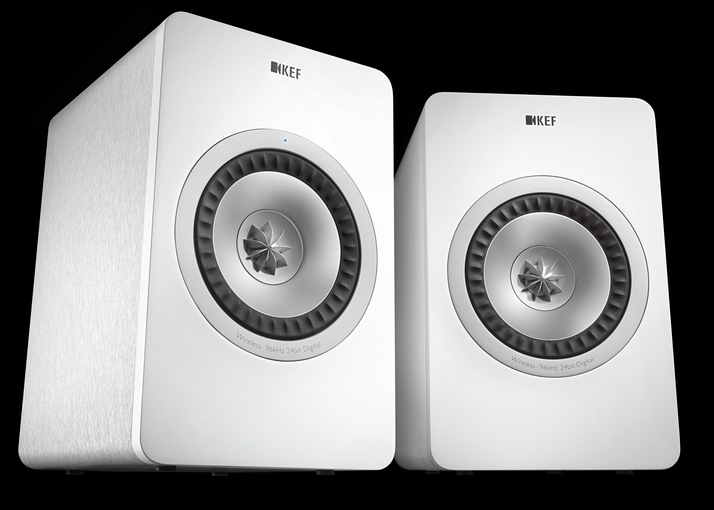There are two ways this ‘wireless’ edition differs from the original KEF X300A – it comes solely in a white vinyl finish, rather than black only. And it adds a Wi-Fi network adaptor internally to let it connect to 802.11g wireless networks. Peripheral to that, there’s also the reliable standby of an ethernet port available, the preferred way to pipe media files reliably. (See all audio reviews.) With either network connection, Apple devices such as a MacBook, iPhone or iPad can be easily paired for playing music. And besides Apple AirPlay you can also use the X300A Wireless speakers on a network using UPnP. On first sight, the KEF X300A Wireless still looks like a regular bookshelf hi-fi speaker, albeit one with an unusual dual-concentric speaker driver that KEF calls Uni-Q. There’s no grille option so these drivers are always on display. Instead of the classic tweeter above mid-bass driver layout, the tweeter is embedded into the centre of the main driver. Coincident wavefronts from transducers that cover most the audible frequency range is usually considered a Good Thing. These KEF Uni-Q units typically create a more even tonal balance from different listening positions, and assist stereo imaging. This was demonstrably the case here, as we found a remarkably consistent sound from different locations in the room. A two-position switch on the back (Stand/Desk) helps you adjust the acoustic characteristics for either positioning; this tweak is usually made to the bass response, reducing the low-frequency output slightly when used closer to a room boundary, such as a wall. (See also: Turn a song on your iPhone into a ringtone.)
KEF X300A Wireless review: Build and design
The KEF X300A Wireless speakers resemble the long-running brand’s typical fare of high-fidelity loudspeakers over the last few decades; but unlike most hi-fi speakers these are self-powered, with four separate channels of amplification. They also feature active crossovers, working in the analogue domain, for splitting the sound into appropriate treble and mid/bass frequency bands before arriving at the amplifiers. This is a crucial step, one used in professional PA and studio monitors, which can truly optimise the signal for each speaker driver. It’s also a more efficient way to power any speaker, with less energy wasted in heating up a passive crossover. In this system, the amplifiers and supporting electronics all live inside the speakers – and that includes D-A convertors (DACs) to let you feed the X300A Wireless speakers with a digital signal, up to the 24-bit/96 kHz standard, through a Mini-USB 2.0 input.
It’s notable that the amplifiers used are high-fidelity Class AB designs (50 W mid/bass, 20 W treble), and not the music-crushing Class D type that is universally used in budget audio kit. The main carcass of the speaker box resembles course-grained metal, although it’s a vinyl wrap over thick-walled MDF. Build quality is essentially faultless. These speakers feel incredibly solid and they’re weighty too at 7.5 kg apiece. Printed around silver trim rings is a legend reading ‘Wireless’ and ‘96kHz 24bit Digital’ – but it’s worth remembering that for AirPlay use at least the two are not mutual. This type of wireless audio is limited to 16-bit CD quality at best. On the back of the left speaker – the boss unit of the pair – there’s USB port for digital audio from a computer, as well as a 3.5 mm minijack analogue input. A second USB port sends the signal to the right-hand speaker over a long USB cable. To tailor the sound for either Desk or Stand use there’s the small slide switch here, while a rotary trim knob lets you adjust overall volume gain. You’d normally set your source to its maximum volume, then turn up the gain control to reach the highest output you’d expect to need; then reduce volume as required again on the source component. While music can be piped into the speakers using microwave radio instead of connecting wires, they are clearly far from wireless, as each requires a mains power lead; plus there’s the USB cable that tethers the two boxes together. This also limits somewhat how far apart you can space the two speakers, although the supplied USB cable is a few metres long and for desktop use at least that ought to be enough.
KEF X300A Wireless review: Performance
These are incredibly insightful loudspeakers, and yet tonally deliciously neutral. We ran them from a MacBook Pro over USB, playing a variety of 16-bit ripped CD lossless files, as well high-resolution 24/96 material. And then we turned to the wireless connection, streaming high-bitrate internet radio and lossless audio files. Regular CD music had a clarity and sparkle that we’ve not heard at this price level before – the overall grip and cohesiveness of sound outclassed what you might have expected from, say, a traditional stereo hi-fi amp and loudspeaker combination of £300 each. Voices were fixed naturally in the space between the speakers, and free of unwanted chestiness from the cabinet or sibilance from the all-metal drivers. Acoustic music played convincingly, capturing the air and space around instruments while showing authentic timbre of guitars or violins, for example. And the Uni-Q helped lock the sound such that the soundfield remained consistent in size and spread.
Given weightier music material, the X300A Wireless could also step up and keep up. In fact their tight, focused bass made them great for rock and jazz material, remaining in control even at higher volumes where other speakers start sounding messy. The rear-ported design helped them to go convincingly low in the bass, yet without troubling low-frequency port or box resonances. The takeaway summary is that this is a speaker that plays music so effortlessly, you can listen all day and not grow tired from some niggling edginess or phasey distortion. Music flows smoothly and naturally – and that is a refreshing change for any speaker pitched into the PC speaker market. (See also: How to convert YouTube video to MP3.)


